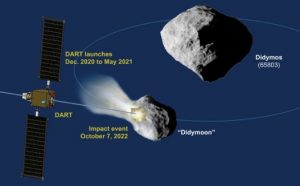
This article originally appeared on The Sun and was reproduced here with permission. Space experts have already identified at least 26,000 so-called “near-Earth objects”.Īn estimated 4,700 meet NASA’s classification as “Potentially Hazardous Objects”. DART is designed to test the tech that could one day save Earth from killer asteroids. Instead, NASA’s intrepid battering ram will set its sights on a smaller asteroid – or moonlet – orbiting Didymos closely.ĭART will smash into the space rock at 15,000 mph in an attempt to change its orbital trajectory around its host.Īfter DART crashes into its target, NASA and ESA telescopes on Earth will pour over it to check whether the scheme has worked.Ī tiny cubesat launched alongside the mission will collect data before, during and after the impact. DART is expected to reach its target in September 2022. The scheme mirrors the plot of Hollywood mega-hit “Armageddon” in which NASA flies a spacecraft to an asteroid to stop it hitting Earth.ĭART is flying towards the binary near-Earth asteroid Didymos, which is about 740 meters (2,427 feet) across and sits between the orbits of Earth and Mars.īut that’s not strictly the focus of the mission. Should the mission prove successful, it could pave the way for a new planetary defense system that can deflect incoming space rocks before impact. 10, DART’s DRACO camera captured and returned this image of the stars in Messier 38, or the Starfish Cluster, which lies some 4,200 light years away. Scientists have been able to make out about a dozen stars, near where the constellations Perseus, Aries and Taurus intersect.īut DART isn’t due to reach its final destination until September 2022, so we can expect more photos to come during its long journey. Taken some 2million miles from Earth, the slightly grainy shot was made possible using the DRACO telescopic camera on board. The spacecraft opened its “eye” two weeks after blasting off from a base in California back in November and we can now get a glimpse of its trip.
ITS SPACE EYE NASA DART FIRST TRIAL
Its aim is to trial tech that could defend Earth from potentially devastating asteroids in the future. The Double Asteroid Redirection Test (DART) is currently hurtling through space on an Armageddon-style mission. I bit into a KFC burger and found a massive cockroachĪ spacecraft designed to crash into an asteroid 11 million miles from Earth has sent back its first photo from outer space. Kourtney Kardashian slammed for showing off sexy lingerieĮxpert warns Putin will trigger WWIII unless 'Biden caves in' Yunnan Observatory successfully used the telescope laser ranging system to bounce light off a retroreflector placed on the Moon during NASA's Apollo 15 crewed lunar mission early last year.Urgent Apple warning issued to 1.65 billion iPad and iPhone users

The laser corner retro-reflector will receive laser light from an Earth station and reflect the light back to Earth. The Queqiao retroflector will be used to test ranging ability of the 1.2-metre telescope laser ranging system at the Yunnan Observatory at Kunming, under the Chinese Academy of Sciences, and the experiment could take place next month, says Li Yuqiang from Yunnan Observatory. If not, one suggestion for an extended mission would see Queqiao head to other Earth-Moon Lagrange points to confirm if the areas of stable orbits host small bodies, or ‘Trojans’, just as similar libration points in the Jupiter system do. There’s the possibility that Queqiao will have fuel enough to assist future missions, as the current outline for the planned Chang’e-7 mission to the lunar south pole in the early 2020s requires such a craft. The relay sat is also carrying a 170-millimeter large-aperture laser angle reflector, which is a test instrument for carrying out laser ranging measurements and likely a precursor to a retroreflector for a future Chang’e landing mission. Like the Low Frequency Spectrometer (LFS) on Chang’e-4, NCLE consists of three 5-meter-long booms.

Marc Klein Wolt of Radboud University and project leader for the Netherlands-China Low-Frequency Explorer (NCLE), says the instrument will be switched on after the nominal 3-month lifetime of Yutu-2, in preparation to make unprecedented low-frequency radio observations of the solar system and potentially pick up signals from the cosmic dark ages. Queqiao has some other cool tricks up its robotic sleeves.


 0 kommentar(er)
0 kommentar(er)
